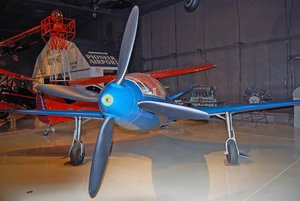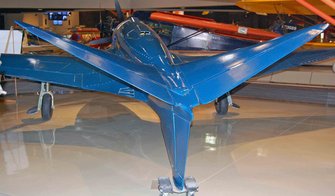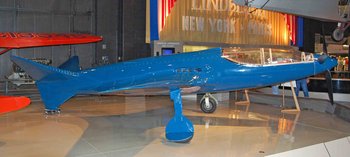Bugatti Model 100
Model 100 Facts
The Bugatti Model 100 is of wood monocoque “sandwich” construction. On a polyhedral frame, layers of balsa wood are glued and carved to achieve the proper aerodynamic shape. . Hardwood rails and supports are set into the balsa wood to take concentrated loads at stress points such as the engine mount and canopy. The canopy is integrated into the fuselage forming an unbroken streamline from the nose to the tail. The airframe is completely covered with tulip wood strips, sanded and filled, then covered with linen and doped.
The Bugatti’s wing is unique with its forward canted leading edge. The single box wing spar carries completely through the fuselage forming a one-piece wing. The wood framed, fabric covered ailerons are push rod operated with one section threaded to fit into the next. A trim crank in the cockpit screws the rod section in or out through a chain and sprocket. Fuel was carried inside the spar and drained by gravity into a center section tank fitted with a pump.
The Bugatti’s V-tail design was created in 1939, a full five years ahead of the now familiar Beechcraft V-tail. The Learfan, designed by Bill Lear, started with a three component empennage with the vertical fin up and the other two fins down. Wind tunnel testing proved that the reverse configuration, the Bugatti choice, was the superior arrangement. The Bugatti tail surfaces consist of two butterfly units and a ventral fin at 120-degree angles. Constructed using the same “sandwich” method as the fuselage and wing, Bugatti’s design for the V-tail control system was awarded a French patent in 1939.
For the Model 100 racer, Bugatti used two of his famous 50B engines modified for aircraft use. The engines, which are no longer in the aircraft, were between 4.7-4.9 liters. Crankcases were made of magnesium to reduce weight. The engines were situated almost one behind the other behind the pilot. Drive shafts passed on either side of the pilot literally under the armpit and met at a reduction gearbox in the front of the craft.
The aircraft is fitted with two metal, ground-adjustable, contra-rotating Ratier propellers. The rear propeller shaft is hollow, allowing the front shaft to rotate inside of it. Other features of the plane include a V-shaped radiator, leaf spring suspension and double downdraught carburetors. The cooling system was designed specifically to reduce cooling drag to a minimum. Inlet slots for cooling air are on the leading edges of the butterfly tail and the ventral fin. Cooling air is ducted forward through the split radiator located behind the engines and exhausted at low-pressure areas behind the wing’s trailing edge. No fans or blowers were required. Source


